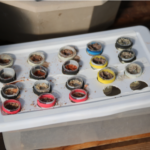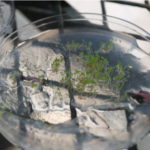Crew 205 – International Emerging Space Leaders
Submitted and prepared by GreenHab Officer Nathan Hadland
1.) ISRU Study: Continued characterization of the regolith samples have produced interesting properties. The pH of most of the samples have yielded a pH that is neutral or slightly alkaline with the exception of one, which is slightly acidic. These values suggest that the substrates may be good candidates for plant growth and retaining nutrients. Higher pH substrates cause the Hoagland’s #2 hydroponic nutrient supplement to precipitate out. The probes in the Science Dome to investigate conductivity and redox potential are not operational, so this property will not be investigated until returning to Florida Tech. Using an agar media plug, germinated Arabidopsis thaliana seeds were transferred from the agar germination plate into regolith samples. However, the regolith is exhibiting interesting wettability properties, largely drying out within several hours despite ample watering, effectively killing the fragile Arabidopsis seedlings quickly overnight. The Arabidopsis seeds were planted again this afternoon, with more plants per sample and care to arrange the regolith around the plug to prevent quick dehydration. Dead plant material from the GreenHab was taken and dried using an oven in the Science Dome and subsequently weighed for the cellulosic ethanol ISRU study. We will begin a study soon mixing the regolith samples with potting soil to try to improve the success of this study. See attached pictures to see experimental design.
2.) GreenHab: The inventory of equipment in the Science Dome and GreenHab as well as the plants currently growing is nearing completion and we have begun a list of the seed bank. We suggest these lists to be available to crews prior to rotation and checked and updated while at MDRS. This will improve the ability of crews to design experiments and mission plans effectively and improve the efficacy and safety of all participants involved. Additionally, the sugar snap peas appear to be stagnating, so a nutrient supplementation solution (Miracle Grow) was diluted using the industry standard and applied to the base of the peas along with a few other species sparingly.
3.) EVA Project: The success of an extravehicular activity (EVA) depends highly on both the EVA crew and CapCom crew being aware of the planned objectives and the intended route. This means that both parties should conduct the planning of the EVA together, in order to understand what is to be accomplished and what hazards could change the EVA’s outcome. Crew and CapCom should also be in contact during the EVA for both safety and additional information on EVA progress. The following post-EVA checklist will allow crews of planetary exploration analog sites going on EVAs to expose deficiencies in both the planning and execution of the EVA. This process allows planners and team members to improve their process of preparing for an EVA. This will lead to more effective and safe EVAs.
4.) SOP and Guidelines for Future Crews: So far, the IESL Crew (Crew 205) have drafted Standard Operating Procedures (SOPs) that provide checklists for leaders, HSOs and support crew for before and after EVA missions. These SOPs will improve efficiency, reduce ambiguity and streamline the processes involved in preparing for and executing surface operations safely and effectively. Some of the overwhelming themes contained in these SOPs are:
o Ensuring that requisite special mission equipment is secured and checked prior to EVAs
o Ensuring that participants understand both the objectives and scheme of movement for the EVA
o Ensuring that durable equipment (EVA suits, tools, etc.) is operable and mission-ready prior to EVA, and is properly recovered afterwards, with maintenance needs immediately annotated
o Ensuring that potential risks have been identified and mitigated prior to departure
o Ensuring that all of these requisite tasks are completed by every EVA team of every crew as an operational standard, not a mere suggestion
5.) Astronomy: One week has passed since the start of crew 205 rotation. Two observations were submitted, but the weather prohibited the completion of one observation. The target observed was SY MON, while we called the other target MDRS Target 1. 4 photometry measurements were performed for SY MON as per the below table. The Magnitude Value of 14.132 was submitted for the AAVSO website.
| Mag Value | Comp Stars Labels | Check Star Label | Error | Comment |
| 14.147 | 93 111 122 134 148 | No Check Stars were used | 0.01568 | This measurement was repeated because of no check star was used, CCD setting was wrong and there are better ways to select comp stars. |
| 13.918 | 140 143 132 97 | Check star used indicates bad measurement or check star itself was saturated | Measurement repeated | |
| 14.118 | 140 143 132 | No check star because this is manual calculation | It was found that Comp 97 positioned outside the straight line of the curve, thus it was decided to exclude it. | |
| 14.132 | 140 143 132 | 122 | 0.0185 | Data was submitted to AAVSO |




You must be logged in to post a comment.